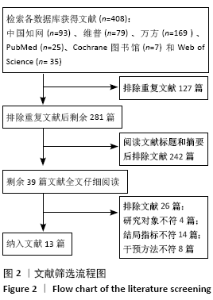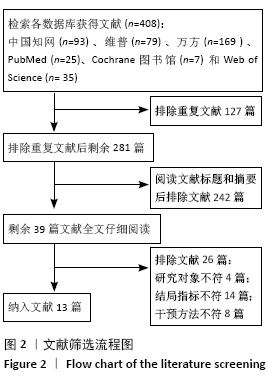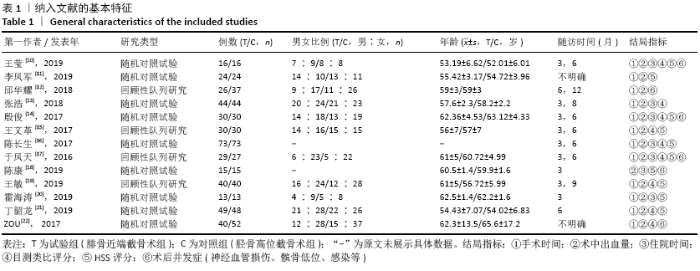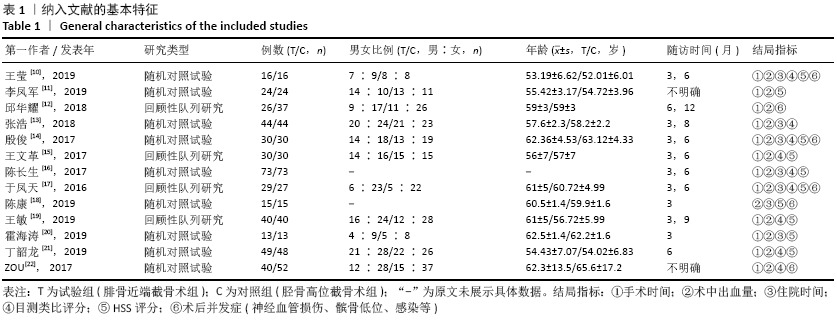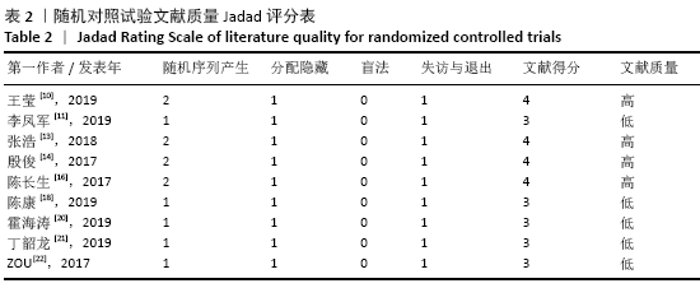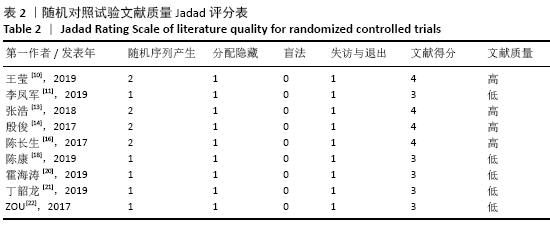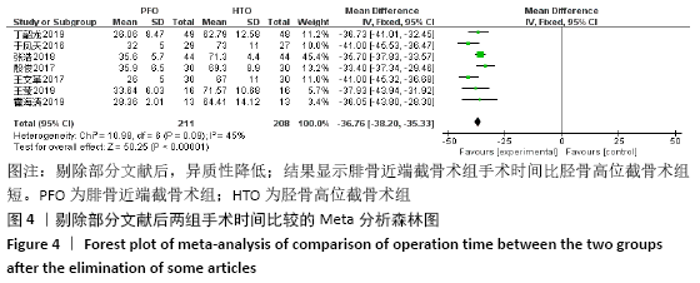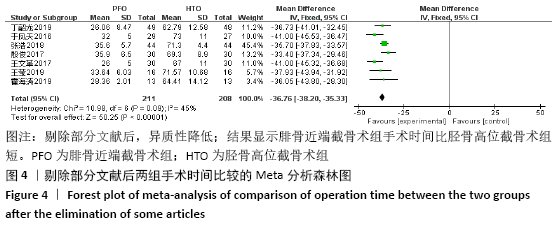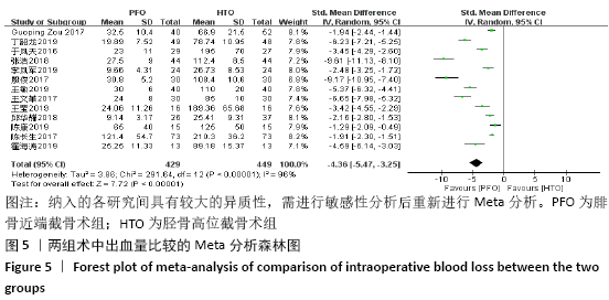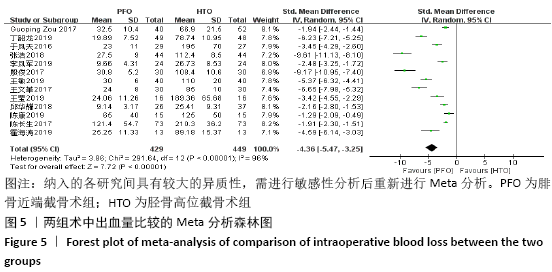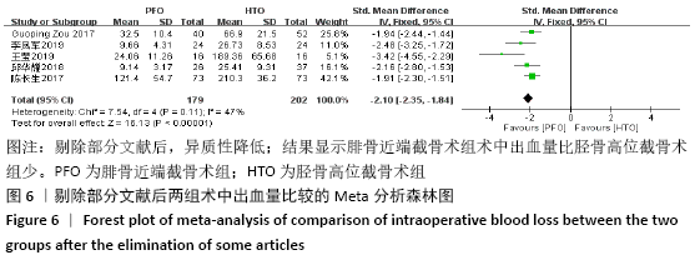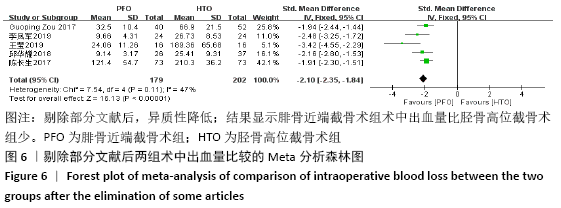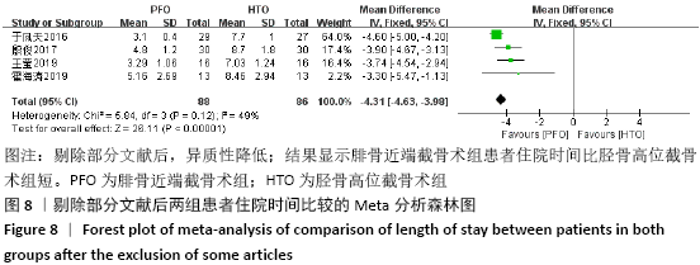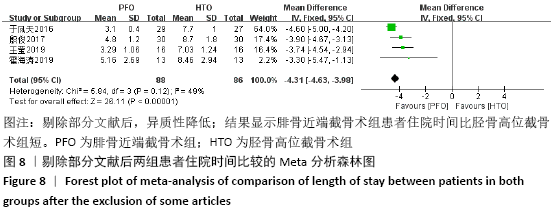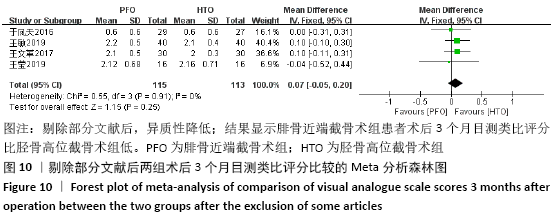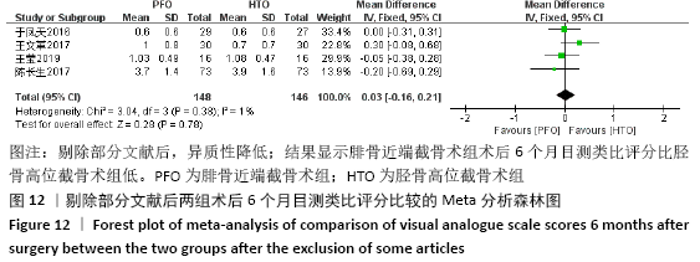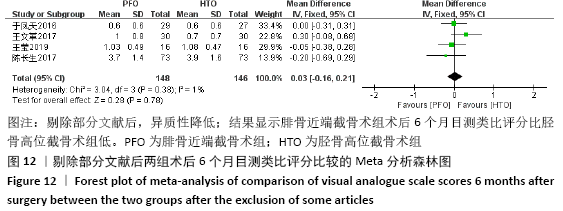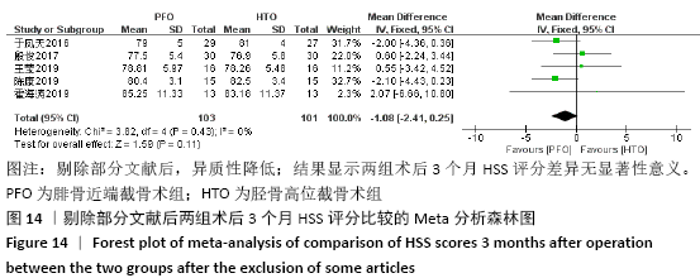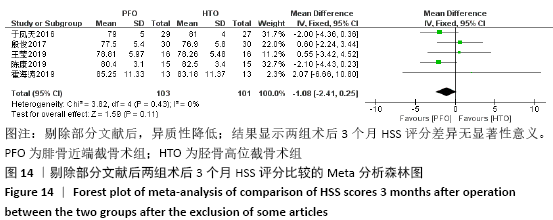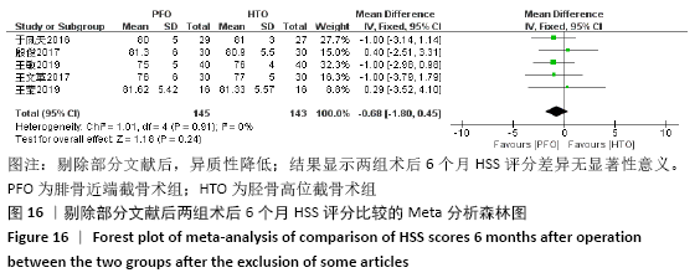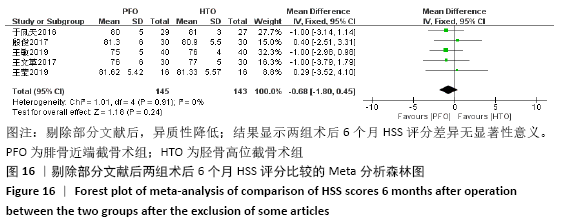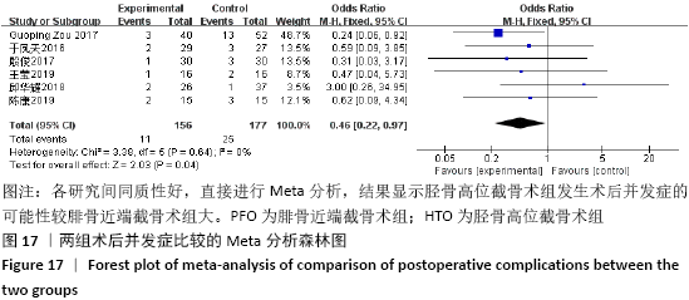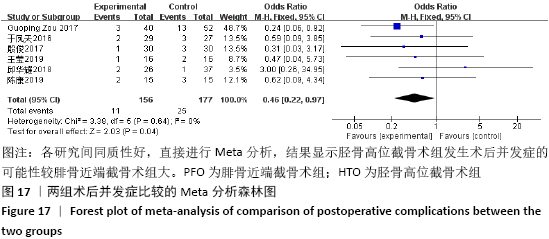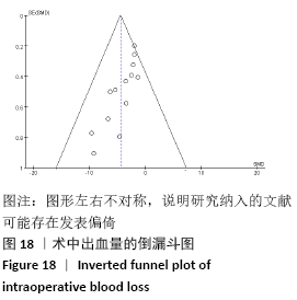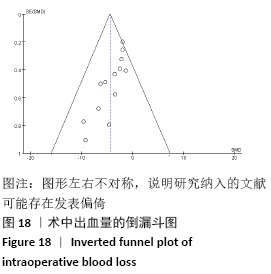Chinese Journal of Tissue Engineering Research ›› 2021, Vol. 25 ›› Issue (18): 2945-2952.doi: 10.3969/j.issn.2095-4344.3848
Meta-analysis of safety and effectiveness of proximal fibular osteotomy and high tibial osteotomy in the treatment of knee osteoarthritis
Huang Zeling1, Shi Shanni1, He Junjun1, 2, Gao Hongjian1, Ge Haiya1, Hong Zhenqiang1, 2
- 1School of TCM, Fujian University of Traditional Chinese Medicine, Fuzhou 350122, Fujian Province, China; 2Key Laboratory of Orthopedics & Traumatology and Rehabilitation of Traditional Chinese Medicine, Ministry of Education, Fuzhou 350122, Fujian Province, China
-
Received:2020-08-07Revised:2020-08-11Accepted:2020-09-11Online:2021-06-28Published:2021-01-12 -
Contact:Hong Zhenqiang, Master, Master’s supervisor, School of TCM, Fujian University of Traditional Chinese Medicine, Fuzhou 350122, Fujian Province, China; Key Laboratory of Orthopedics & Traumatology and Rehabilitation of Traditional Chinese Medicine, Ministry of Education, Fuzhou 350122, Fujian Province, China -
About author:Huang Zeling, Master candidate, School of TCM, Fujian University of Traditional Chinese Medicine, Fuzhou 350122, Fujian Province, China -
Supported by:the “Spleen and Stomach Advantage Characteristic Discipline” Construction Project of Fujian University of Traditional Chinese Medicine, No. X2019006-XK (to HZQ)
CLC Number:
Cite this article
Huang Zeling, Shi Shanni, He Junjun, Gao Hongjian, Ge Haiya, Hong Zhenqiang. Meta-analysis of safety and effectiveness of proximal fibular osteotomy and high tibial osteotomy in the treatment of knee osteoarthritis[J]. Chinese Journal of Tissue Engineering Research, 2021, 25(18): 2945-2952.
share this article
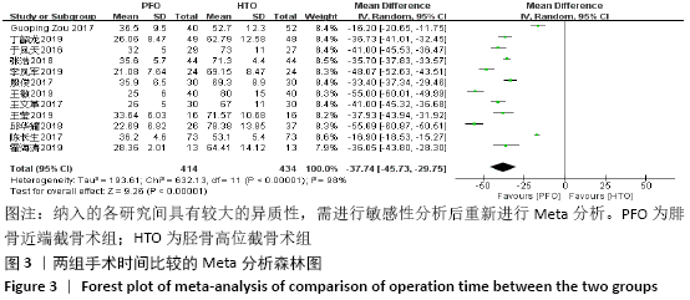
2.3 Meta分析结果 2.3.1 各组手术时间差异 有12项研究对比了两组的手术时间[10-17,19-22],异质性分析显示纳入的研究间具有较大的异质性(P < 0.000 01,I2=98%),见图3,根据森林图考虑,异质性可能由偏离森林图的部分文献导致,剔除该部分文献后重新进行Meta分析,共纳入7项研究[10,13-15,17,20-21],419例患者,其中腓骨近端截骨术组211例,胫骨高位截骨术组208例。异质性分析结果显示纳入的各研究间异质性低(P=0.09,I2=45%),采用固定效应模型进行分析,结果表明腓骨近端截骨术组所用的手术时间比胫骨高位截骨术组短(MD= -36.76,95%CI:-38.20至-35.33,P < 0.000 01),见图4。 "
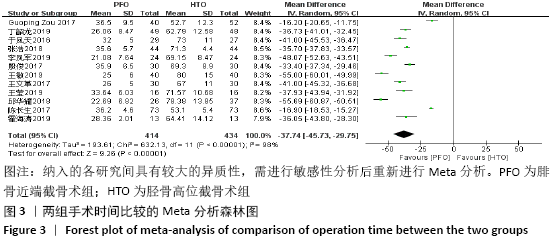
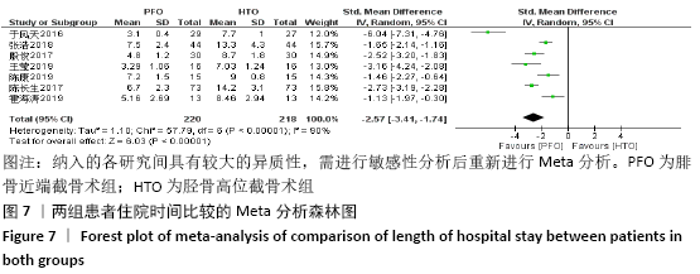
2.3.3 各组住院时间差异 有7项研究对比了两组患者的平均住院时 间[10,13-14,16-17,20-21],异质性分析结果显示纳入的各研究间具有较大的异质性 (P < 0.000 01,I2=90%),见图7,剔除部分偏离森林图的文献后重新进行Meta分析,共纳入4项研究[10,14,17,20],共174例患者,其中腓骨近端截骨术组88例,胫骨高位截骨术组86例。异质性分析结果显示纳入的各研究间异质性低(P=0.12,I2=49%),采用固定效应模型进行分析,结果表明腓骨近端截骨术组术患者住院时间比胫骨高位截骨术组更短(MD=-4.31,95%CI:-4.63至-3.98,P < 0.000 01),见图8。 "
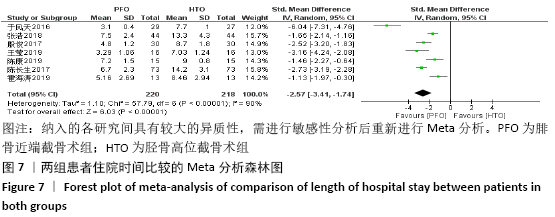
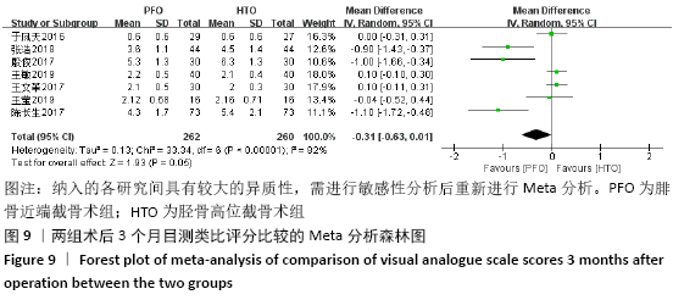
2.3.4 各组术后疗效指标差异 术后3个月目测类比评分:有7项研究对比了两组患者术后3个月的目测类比评分[10,13-17,19],异质性分析显示纳入的各研究间具有较大的异质性(P < 0.000 01,I2=82%),见图9,剔除部分偏离森林图的文献后重新进行Meta分析,共纳入4项研究[10,15,17,19],228例患者,其中腓骨近端截骨术组115例,胫骨高位截骨术组113例。异质性分析结果显示纳入的各研究间存在同质性(P=0.91,I2=0%),采用固定效应模型进行分析,结果表明腓骨近端截骨术组患者与胫骨高位截骨术组患者术后3个月的目测类比评分无显著差异(MD=0.07,95%CI: -0.05-0.20,P=0.25),见图10。"
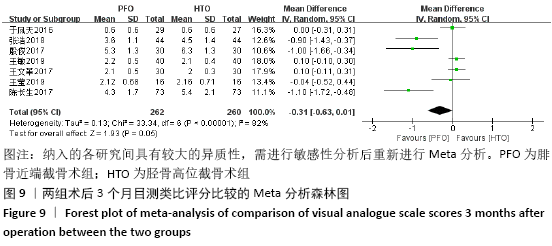
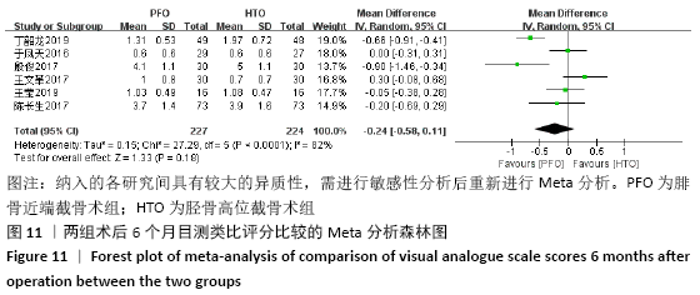
术后6个月目测类比评分:有6项研究对比了两组患者术后6个月的目测类比评分[10,14-17,22],异质性分析显示纳入的各研究间具有较大的异质性(P < 0.0001,I2=82%),见图11,剔除部分偏离森林图的文献后重新进行Meta分析,共纳入4项研究[10,15-17],294例患者,其中腓骨近端截骨术组148例,胫骨高位截骨术组146例。异质性分析结果显示纳入的各研究间存在同质性(P=0.38,I2=1%),采用固定效应模型进行分析,结果表明术后6个月腓骨近端截骨术组患者与胫骨高位截骨术组目测类比评分无差异(MD=0.03,95%CI:-0.16-0.21,P=0.78),见图12。 "
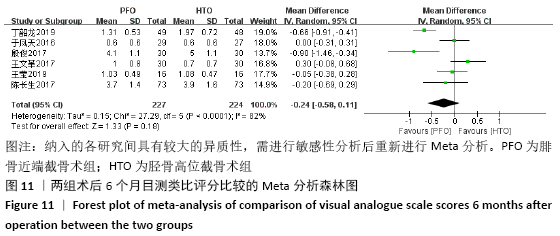
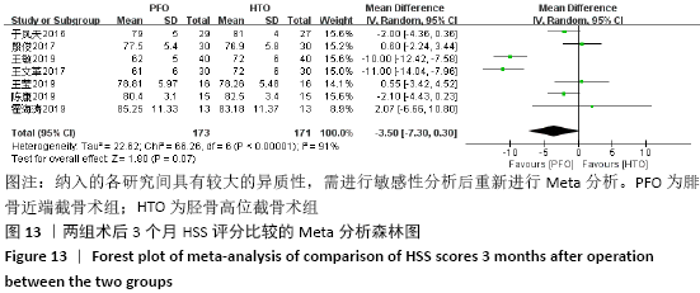
术后3个月HSS评分:HSS评分是美国纽约特种外科医院提出的评分系统,包括疼痛、功能、肌力、屈曲畸形、活动范围及关节稳定性等。有7项研究对比了两组患者术后3个月的HSS评分[10,14-15,17-20],异质性分析显示纳入的各研究间具有较大的异质性(P < 0.000 01,I2=91%),见图13,剔除部分偏离森林图的文献后重新进行Meta分析,共纳入5项研究[10,14,17-18,20],204例患者,其中腓骨近端截骨术组103例,胫骨高位截骨术组101例。异质性分析结果显示纳入的各研究间存在同质性(P=0.43,I2=0%),采用固定效应模型进行分析,结果表明术后3个月腓骨近端截骨术组患者与胫骨高位截骨术组患者HSS评分无显著差异(MD=-1.08,95%CI: -2.41-0.25,P=0.11),见图14。 "
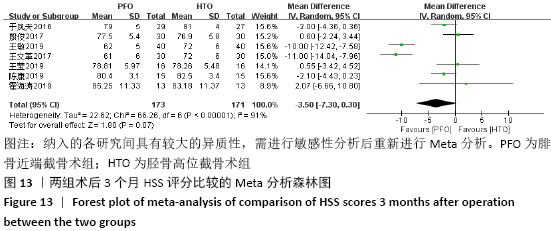
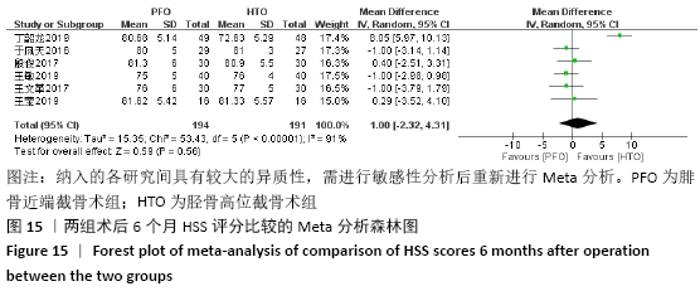
术后6个月HSS评分:有6项研究对比了两组患者的术后6个月HSS评分[10,14-15,17,19,21],异质性分析显示纳入的各研究间具有较大的异质性(P < 0.000 01,I2=91%),见图15,剔除部分偏离森林图的文献后重新进行Meta分析,共纳入5项研究[10,14-15,17,19],288例患者,其中腓骨近端截骨术组145例,胫骨高位截骨术组143例。异质性分析结果显示纳入的各研究间存在同质性(P=0.91,I2=0%),采用固定效应模型进行分析,结果表明术后6个月腓骨近端截骨术组患者与胫骨高位截骨术组HSS评分无显著差异(MD=-0.68,95%CI: -1.80-0.45,P=0.24),见图16。 "
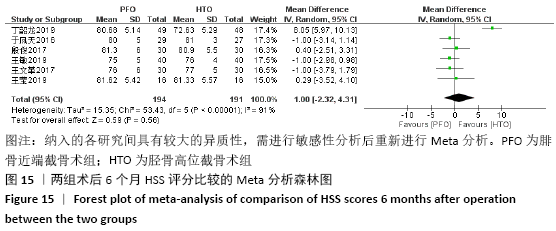
| [1] 帖小佳,郑如庚,赵梦,等.中国中老年人膝关节骨关节炎患病率的Meta分析[J].中国组织工程研究,2018,22(4):650-656. [2] 张朝鸣,林天烨,陈雷雷,等.人工全膝关节置换治疗膝关节外翻畸形[J].中国组织工程研究,2020,24(33):5277-5282. [3] VAISHYA R, BIJUKCHHE AR, AGARWAL AK, et al. A critical appraisal of medial open wedge high tibial osteotomy for knee osteoarthritis. Clin Orthop Trauma. 2018;9(4):300-306. [4] 陈伟,秦迪,吴涛,张飞,等.应用腓骨截骨术治疗膝关节骨性关节炎效果优良的机制分析[J].河北医科大学学报,2015, 36(6):726-727,745. [5] 张英泽,李存祥,李冀东,等.不均匀沉降在膝关节退变及内翻过程中机制的研究[J].河北医科大学学报,2014,35(2): 218-219. [6] 李子涛,廉洪宇,荣凤菊,等.胫骨高位截骨术与腓骨截骨术治疗膝骨关节炎临床疗效比较[J].中国医药科学,2020, 10(4):17-21. [7] JADAD AR, MOORE RA, CARROLL D, et al. Assessing the quality of reports of randomized clinical trials: is blinding necessary? Control Clin Trials. 1996;17(1): 1-12. [8] WELLS G, SHEA B, O’CONNELL D, et al. The Newcastle-Ottawa Scale (NOS) for Assessing the Quality of Non-Randomised Studies in Meta-Analyses// Symposium on Systematic Reviews: Beyond the Basics. 2014. [9] MARION-MARTINS AD, PINHO DLM. Interprofessional simulation effects for healthcare students: a systematic review and meta-analysis. Nurse Educ Today. 2020; 94:104568. [10] 王莹,杨益民,尹思,等.腓骨近端截骨术与胫骨高位截骨术治疗内侧间室性膝关节骨关节炎的比较研究[J].现代生物医学进展,2019,19(21):4197-4200. [11] 李风军.胫骨高位截骨术与腓骨截骨术治疗膝内侧骨关节炎临床疗效比较[J].临床医药文献电子杂志,2019,6(85):5-7. [12] 邱华耀,冯宗权,王卫刚.胫骨高位截骨术与腓骨截骨术治疗膝骨关节炎临床疗效比较[J].中华关节外科杂志(电子版), 2018,12(5):676-680. [13] 张浩,王怀东,张富军,等.胫骨高位截骨与腓骨近端截骨治疗膝骨关节炎伴膝内翻畸形的近远期疗效比较[J].临床医学研究与实践,2018,3(21):87-88. [14] 殷俊,郑闽前,邹国友,等.不同截骨手术方案治疗内翻型膝关节炎的近期疗效比较[J].山东医药,2017,57(33):87-89. [15] 王文革,李仕臣,赵艳东,等.腓骨近端截骨术和胫骨高位截骨术治疗早期膝关节骨关节炎的短期疗效比较[J].中华老年骨科与康复电子杂志,2017,3(2):91-96. [16] 陈长生.不同治疗手段治疗内翻型膝关节骨关节炎的短期疗效比较[J].中国继续医学教育,2017,9(7):144-146. [17] 于风天,魏杰,王晓东.腓骨近端截骨术与胫骨高位截骨术治疗内翻型膝关节骨关节炎的疗效比较[J].中华老年骨科与康复电子杂志,2016,2(2):97-102. [18] 陈康.腓骨近端截骨术和胫骨高位截骨术治疗膝内翻型骨性关节炎效果比较[J].医药前沿,2019,9(29):45-46. [19] 王敏,乔锋,廖永华,等.胫骨高位截骨术与腓骨近端截骨术治疗膝关节前内侧骨关节炎临床疗效比较[J].美中国际创伤杂志,2019,18(2):25-27, 42. [20] 霍海涛,秦少飞,张海军,等.腓骨近端截骨术治疗早期膝关节骨关节炎的效果观察[J].临床医药文献电子杂志,2019, 6(37):95. [21] 丁韶龙.腓骨近端截骨术对膝骨关节炎患者术后膝关节功能及生活质量的影响[J].医药论坛杂志,2019,40(2):108-110. [22] ZOU G, LAN W, ZENG Y, et al. Early clinical effect of proximal fibular osteotomy on knee osteoarthritis. Biomed Res. 2017;28(21): 9291-9294. [23] 褚立希,王锋.膝骨关节炎X片生物力学及形态学测量分析[J].中西医结合学报,2004,2(6):432-434. [24] Vaish A, Kumar Kathiriya Y, Vaishya R. A critical review of proximal fibular osteotomy for knee osteoarthritis. Arch Bone Jt Surg. 2019;7(5):453-462. [25] YANG ZY, CHEN W, LI CX, et al. Medial compartment decompression by fibular osteotomy to treat medial compartment knee osteoarthritis: a pilot study. Orthopedics. 2015;38(12):1110-1114. [26] SCHUSTER P, GEBLEIN M, SCHLUMBERGER M, et al. Ten year results of medial open wedge high tibial osteotomy and chondral resurfacing in severe medial osteoarthritis and varus malalignment. Am J Sports Med. 2018;46(6):1362-1370. [27] 刘培来,李松林.胫骨高位截骨术力线控制的过去、现在和未来[J].中华外科杂志, 2020,58(6):7. [28] EKHTIARI S, HALDANE CE, DE SAD, et al. Return to work and sport following high tibial osteotomy: a systematic review. J Bone Joint Surg Am. 2016;98(18):1568-1577. [29] 黄野,柳剑,王兴山,等.胫骨高位截骨术适应证解析[J].中华外科杂志,2020, 58(6):420-426. [30] 莫诒向,邓羽平,黄文华,等.腓骨高位截骨术对胫骨平台的生物力学分析[J].中国医学物理学杂志,2020,37(5):644-648. [31] WANG X, WEI L, LÜ Z, et al. Proximal fibular osteotomy: a new surgery for pain relief and improvement of joint function in patients with knee osteoarthritis. J Int Med Res. 2017;45(1):282-289. [32] NOVEMBRI UD, FERDIANSYAH M, WIJAYA WA, et al. Proximal fibula osteotomy as an alternative to TKA and HTO in late-stage varus type of knee osteoarthritis. J Orthop. 2018;15(3):858-861. [33] LIU B, CHEN W, ZHANG Q, et al. Proximal fibular osteotomy to treat medial compartment knee osteoarthritis: preoperational factors for short-term prognosis. PLoS One. 2018;13(5):e0197980. |
| [1] | Xu Feng, Kang Hui, Wei Tanjun, Xi Jintao. Biomechanical analysis of different fixation methods of pedicle screws for thoracolumbar fracture [J]. Chinese Journal of Tissue Engineering Research, 2021, 25(9): 1313-1317. |
| [2] | Jiang Yong, Luo Yi, Ding Yongli, Zhou Yong, Min Li, Tang Fan, Zhang Wenli, Duan Hong, Tu Chongqi. Von Mises stress on the influence of pelvic stability by precise sacral resection and clinical validation [J]. Chinese Journal of Tissue Engineering Research, 2021, 25(9): 1318-1323. |
| [3] | Zhang Tongtong, Wang Zhonghua, Wen Jie, Song Yuxin, Liu Lin. Application of three-dimensional printing model in surgical resection and reconstruction of cervical tumor [J]. Chinese Journal of Tissue Engineering Research, 2021, 25(9): 1335-1339. |
| [4] | Zhang Yu, Tian Shaoqi, Zeng Guobo, Hu Chuan. Risk factors for myocardial infarction following primary total joint arthroplasty [J]. Chinese Journal of Tissue Engineering Research, 2021, 25(9): 1340-1345. |
| [5] | Li Dadi, Zhu Liang, Zheng Li, Zhao Fengchao. Correlation of total knee arthroplasty efficacy with satisfaction and personality characteristics [J]. Chinese Journal of Tissue Engineering Research, 2021, 25(9): 1346-1350. |
| [6] | Wei Wei, Li Jian, Huang Linhai, Lan Mindong, Lu Xianwei, Huang Shaodong. Factors affecting fall fear in the first movement of elderly patients after total knee or hip arthroplasty [J]. Chinese Journal of Tissue Engineering Research, 2021, 25(9): 1351-1355. |
| [7] | Wang Jinjun, Deng Zengfa, Liu Kang, He Zhiyong, Yu Xinping, Liang Jianji, Li Chen, Guo Zhouyang. Hemostatic effect and safety of intravenous drip of tranexamic acid combined with topical application of cocktail containing tranexamic acid in total knee arthroplasty [J]. Chinese Journal of Tissue Engineering Research, 2021, 25(9): 1356-1361. |
| [8] | Xiao Guoqing, Liu Xuanze, Yan Yuhao, Zhong Xihong. Influencing factors of knee flexion limitation after total knee arthroplasty with posterior stabilized prostheses [J]. Chinese Journal of Tissue Engineering Research, 2021, 25(9): 1362-1367. |
| [9] | Peng Zhihao, Feng Zongquan, Zou Yonggen, Niu Guoqing, Wu Feng. Relationship of lower limb force line and the progression of lateral compartment arthritis after unicompartmental knee arthroplasty with mobile bearing [J]. Chinese Journal of Tissue Engineering Research, 2021, 25(9): 1368-1374. |
| [10] | Huang Zexiao, Yang Mei, Lin Shiwei, He Heyu. Correlation between the level of serum n-3 polyunsaturated fatty acids and quadriceps weakness in the early stage after total knee arthroplasty [J]. Chinese Journal of Tissue Engineering Research, 2021, 25(9): 1375-1380. |
| [11] | Zhang Chong, Liu Zhiang, Yao Shuaihui, Gao Junsheng, Jiang Yan, Zhang Lu. Safety and effectiveness of topical application of tranexamic acid to reduce drainage of elderly femoral neck fractures after total hip arthroplasty [J]. Chinese Journal of Tissue Engineering Research, 2021, 25(9): 1381-1386. |
| [12] | Wang Haiying, Lü Bing, Li Hui, Wang Shunyi. Posterior lumbar interbody fusion for degenerative lumbar spondylolisthesis: prediction of functional prognosis of patients based on spinopelvic parameters [J]. Chinese Journal of Tissue Engineering Research, 2021, 25(9): 1393-1397. |
| [13] | Lü Zhen, Bai Jinzhu. A prospective study on the application of staged lumbar motion chain rehabilitation based on McKenzie’s technique after lumbar percutaneous transforaminal endoscopic discectomy [J]. Chinese Journal of Tissue Engineering Research, 2021, 25(9): 1398-1403. |
| [14] | Chen Xinmin, Li Wenbiao, Xiong Kaikai, Xiong Xiaoyan, Zheng Liqin, Li Musheng, Zheng Yongze, Lin Ziling. Type A3.3 femoral intertrochanteric fracture with augmented proximal femoral nail anti-rotation in the elderly: finite element analysis of the optimal amount of bone cement [J]. Chinese Journal of Tissue Engineering Research, 2021, 25(9): 1404-1409. |
| [15] | Du Xiupeng, Yang Zhaohui. Effect of degree of initial deformity of impacted femoral neck fractures under 65 years of age on femoral neck shortening [J]. Chinese Journal of Tissue Engineering Research, 2021, 25(9): 1410-1416. |
| Viewed | ||||||
|
Full text |
|
|||||
|
Abstract |
|
|||||
